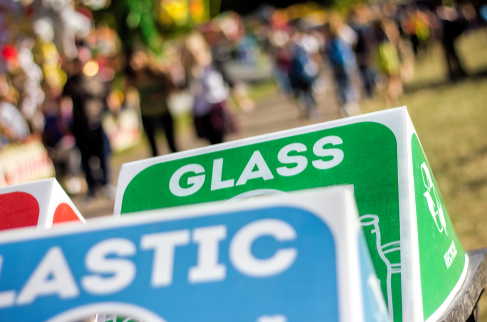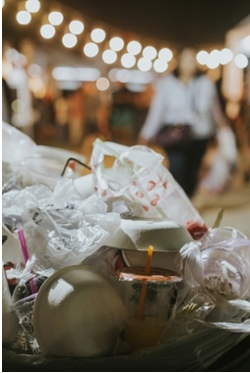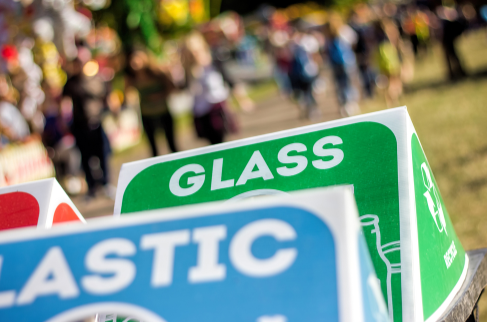4 Step Guide to Reducing Waste at Outdoor Events

Plan ahead to reduce outdoor-event waste.
 Outdoor events can bring a lot of positive experiences. However, when hundreds to thousands of people are gathered in one place for an event, the consequential waste produced is not so positive. To add to the challenge, most outdoor events are held in public spaces without any permanent recycling, waste, and organics programs or bins in place already.
Outdoor events can bring a lot of positive experiences. However, when hundreds to thousands of people are gathered in one place for an event, the consequential waste produced is not so positive. To add to the challenge, most outdoor events are held in public spaces without any permanent recycling, waste, and organics programs or bins in place already.
The responsibility of reducing waste usually falls on event organizers, but to reduce the amount of waste produced, it’s important to get commitment from everyone else involved including: recycling and waste service providers, vendors, patrons, sponsors, performers, contractors, and more.
Anyone involved in the planning or running of the event can use this quick guide to divert more waste from the landfill. There are 4 key stages to waste diversion at outdoor events:
- Planning
- Gaining commitment from stakeholders
- Providing the groundwork
- Educating and promoting
1. Planning
Using the Waste Management Hierarchy (see below), identify areas for improvement.

For example:
- Avoiding waste – Send promotional materials electronically instead of print materials. Patrons can provide their email, take a photo of the information, etc.
- Reducing waste – Encouraging foods that do not require a lot of packaging (i.e. bags, wrapping, utensils, containers) – and instead opt for finger foods with a napkin.
- Reusing materials – Instead of disposable serving ware, wash and reuse current ones. Vendors are encouraged to take home all marketing materials to reuse at another event.
Set waste diversion goals for this year’s event based on the rates from previous years, and the effort to improve upon your previous goal. Your goal should be simple, measurable, achievable, realistic and time-based. For example, Reduce the amount of waste sent to landfill by 20% based on last year or standard levels.
2. Gaining Commitment
Using the plan created in Step 1, gain commitment from stakeholders. This can be in the form of a verbal or written contract.
Event Organizers lead the creation of the waste reduction plan, set targets, and ensure everyone is on board.
- Place trained staff or volunteers near bins to help reduce contamination and encourage proper recycling or composting.
- Control materials to be used at outdoor events and festivals (i.e. banning Styrofoam® packaging)
- Enforce the usage of reusable cups or glasses. Patrons can purchase it at the beginning of the event, use it for the duration, then take home the cup or glass
Vendors should be aware of – and agree to take part in – the waste reduction goals of the event. They usually generate a significant portion of total waste generated at events.
- Supply materials electronically instead of other printed materials during the event
- Purchase supplies in bulk to reduce unnecessary packaging
- Supply condiments in bottles with pumps instead of individual packages
- Use napkins instead of single use serving ware.
- If serving ware is required, select per this order of priority: 1) reusable, 2) compostable, and 3) recyclable. Example: Bonnaroo uses 100% compostable food service products.
- Choose recyclable or compostable packaging when possible
- Avoid providing drinking straws, foam cups, waxed paper goods, and other non-recyclable and non-compostable items
Site Owners hold a big part of the responsibility for implementing the waste reduction plan.
- Make sure the event provides an adequate supply of recycling, waste, and composting bins
Waste Management Service Providers are crucial to the waste reduction efforts at an event.
- Help develop a waste reduction plan (i.e. how many bins, what type of bins, where to place, types of signs)
- Collect different waste streams
Sponsors can help promote the waste reduction message.
- Supply recyclable items and provide sustainable promotional materials
- Include a waste reduction message with their sponsorship
 3. Providing the Groundwork
3. Providing the Groundwork
- Identify the location of highly accessible, busy areas (i.e. near washrooms, entrance and exit, back of the house where food is prepared) and food and beverage vendors, where waste is likely to be produced. Make sure the appropriate bins are available at these locations and clearly labelled. Use a map to plan this out.
- Locate all types of bins (recycling, waste, organics) together so patrons can see the options and select the right bin. This helps reduce contamination.
4. Educating
All staff and volunteers should be fully trained and understand the procedures regarding waste reduction at the event. In return, they will be able to educate the public more accurately and effectively.
Letting patrons know about waste reduction goals are just as important as working with the vendors, sponsors, and contractors. Keep your messages simple and consistent leading up to the event. If there’s an initiative such as a ban on plastic water bottles and patrons should bring a reusable one – announce it ahead of time and often so as many people as possible are aware of it.
Promotions can be done through: signs around the city, on the event e-tickets, press releases, volunteers spreading the word by mouth, social media, TV or radio ads, and relevant blogs.
Don’t forget to communicate your success with your team and evaluate what went well (or didn’t) for even higher waste diversion rates next year!